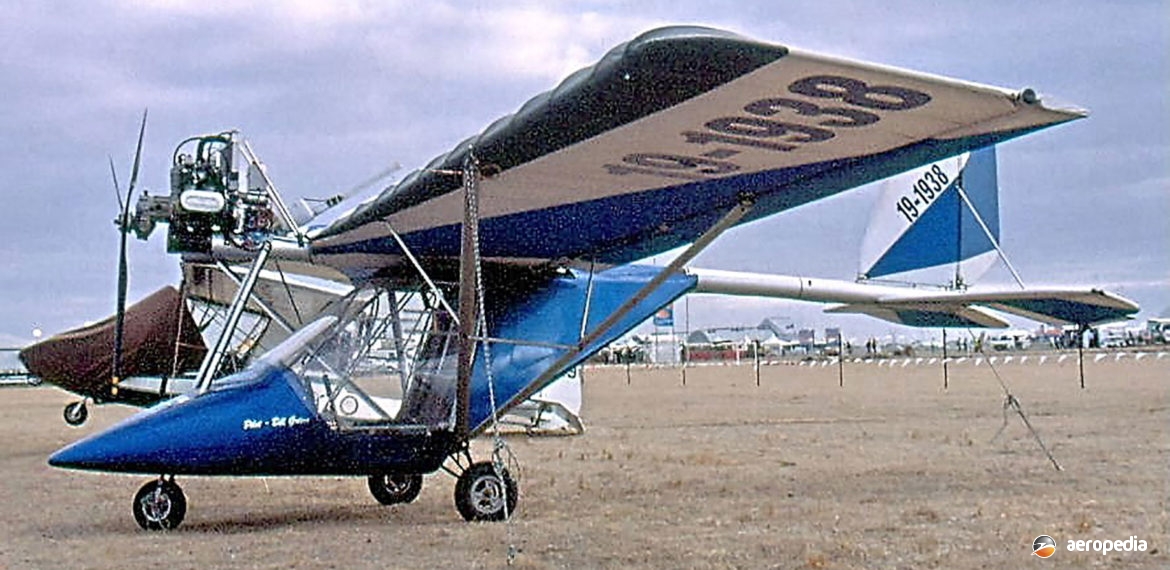Photograph:
Flightstar L1-SL 19-1938 (c/n FAA-001) at Avalon, VIC in 2011 (David C Eyre)
Country of origin:
United States of America
Description:
Two-seat light aircraft
Power Plant:
One 40 kw (54 hp) Rotax 503 two-cylinder, two-stroke, fan-cooled engine
Specifications:
- Wingspan: 9.75 m (32 ft)
- Length: 5.79 m (19 ft)
- Wing area: 14.58 m² (157 sq ft)
- Max speed: 153 km/h (95 mph)
- Cruising speed: 113 km/h (70 mph)
- Stalling speed: 55 km/h (34 mph)
- Rate of climb: 213 m/min (700 ft/min)
- Service ceiling: 3,658 m (12,000 ft)
- Range: 290 km (180 miles)
- Fuel capacity: 38 litres (8.3 Imp gals)
- Take-off roll: 61 m (200 ft)
- Empty weight: 191 kg (420 lb)
- Loaded weight: 431 kg (950 lb)
History:
The Flightstar series of light aircraft was produced in kit form at Ellington, Connecticut, by Flightstar Inc but when first introduced to the market in the early 1980s was known as the Pioneer Flightstar. More than 700 kits have been sold around the world. Examples in Australia hyave been registered under Austtali9an Ultralight Federation (AUF)/ Recreational Aviation Australia (RAA) Regulations but the type could be registered in the homebuilt category.
The Flightstar Formula was introduced in 1990 and was a single-seat high-performance light aircraft fitted with engines in the 30 kw (40 hp) to 45 kw (60 hp) range, including the Rotax 447 of 30 kw (40 hp), and the 45 kw (60 hp) HKS 700E four-stroke unit. During the same year the Flightstar II was introduced, this being a two-seat side-by-side variant fitted with a 40- kw (54 hp) Rotax 503. Later engines in the 36- w (48 hp) to 60 kw (80 hp) range have been installed.
The Flightstar was noted for its comfortable wide cabin and wide-stance tricycle undercarriage. When fitted with the HKS engine it hasd an electric starter, brakes, a full instrument package. Lotus floats co8ld be attached, as coulda BRS parachute. All models had folding wings.
The Flightstar II SL and II SC (sports cabin) variants were two-seaters aimed at the training market and could be fitted with floats. The Spyder was a single-seater for the ultralight market with a front fairing and windshield rather than an enclosed cockpit and could be fitted with the Rotax 447 or 503 engines. Similar to the Formula, the Spyder and Formula were both single-seaters but the Spyder had a gross weight of 295 kg (650 lb) whereas the Formula had a gross weight of 431 kg (950 lb).
A number of Flightstars have been completed in this region. One VH-DFS (c/n N528) was registered on 10 August 2000 in Port Macquarie, NSW. It was fitted with a 56 kw (75 hp) Rotax 618 engine and had optional flaps, rear fuselage fairing, and brakes.
Examples which have appeared on the RAA register have included 10-0985 with a Kawasaki 440 engine; 10-0990 (c/n 721) with a Rotax 503 engine; 10-0063; 10-0099 (c/n 722) with a Rotax 503 engine; 10-0780 (c/n 717) with a Kawasaki TA-440 engine; 10-0843; 10-0197 (c/n 596) with a Rotax 377 engine; 10-0454 (c/n 716) with a Kawasaki TA-440A engine; 10-0697 and 10-0698. Examples were imported to Australia in the early 1980s and marketed by Nason Industries in Melbourne, VIC.

